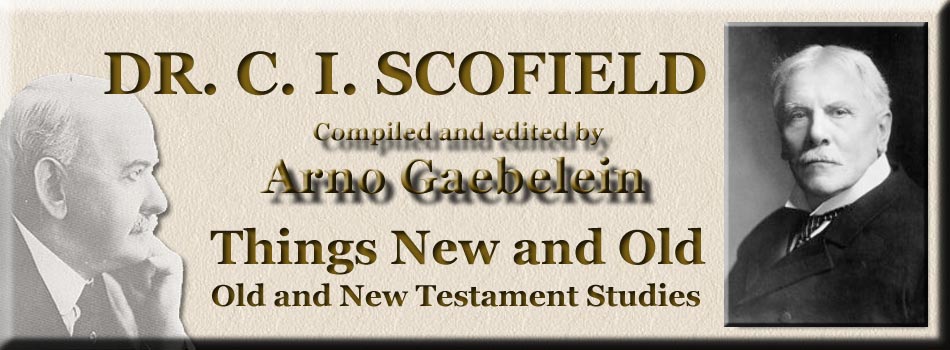
Things New and Old
By Cyrus Ingerson Scofield
Compiled and Edited By Arno Clement Gaebelein
THE SUPPER AT BETHANY.(John xii:1-11.) I. The Analysis. (1) The Supper, verses 1-2. (2) The act of Mary, verses 3-4. (3) The insincere objection, verses 5-6. (4) Jesus' vindication of Mary, verses 7-8. II. The Heart of the Lesson. The central figure in this scene is, incontestably, Mary of Bethany. Our Lord himself makes her so. To her He gives the highest praise ever bestowed by God on a mere human being, "She hath done what she could." Mary of Bethany is the highest type of discipleship in the New Testament, and in this lesson she is seen at her highest reach, so that the character of this simple village girl becomes the heart of the lesson. She comes into the narratives of the earth life of Christ three times, and these have a sequence which must be followed if we are to understand, not Mary alone, but the conditions of the highest discipleship. In the first two scenes she is brought into contrast with her sister Martha; in the last her spiritual intelligence and her utter devoted-ness appear against the foil of the stupidity of all the other disciples, and especially of the traitor, Judas. We meet Mary first sitting at Jesus' feet and hearing His word. It was the place of a learner, of one who would, first of all comprehend her Master. Martha, on the other hand, begins, not by knowing Him, but by a noisy burdened service for Him. She has had her followers in every age. Every church knows them:the bustling, fussy, troubled getters up of fairs, and suppers for the indirect raising of the money which the Bible tells us to quietly give. She, like her modern sisters, has little patience with them who quietly sit at Jesus' feet and she must meet her Lord's gentle rebuke, his vindication of Mary: "She hath chosen that good part, which shall not be taken away from her." We next meet Mary on the occasion of the resurrection of Lazarus. Again she is in contrast with Martha. Mary abides quietly in the house till the Master calls for her; Martha meets and rebukes him, even while confessing a faith shortly to contradict itself at the grave-side. It is easy to repeat a formula, to say, "Yea, Lord," when asked, "Believest thou this?" concerning a great truth; quite another matter to use that faith in the moment of testing. "He hath been dead four days" was the actual measure of Martha's faith. In all this scene little is said of Mary till we come to that statement which we may so easily pass over: "Then many of the Jews which came to Mary, and had seen the things which Jesus did, believed on him." Mary's friends, not Martha's were converted. They saw something in Mary's bearing under trial which convinced them that she had a resource in sorrow all unknown to them. Oh, the power of the quiet faith that has ripened in meditation at Jesus' feet and in the hearing of his word! In the first scene we might well think of Mary as gentle and winsome, but unpractical. Now we see that her Master made no mistake when he said, "Mary hath chosen that good part." And, in the light of that saying how idle to speak of the different temperaments of these two sisters. Jesus said the difference was one of choice, not temperament. And now, in our present lesson, we have Mary in the highest privilege of discipleship, "the fellowship of His sufferings." Only Mary, of all His disciples, had really understood the Master when He said that He must be crucified and rise again the third day. They were dismayed by the crucifixion, and incredulous of the resurrection. But Mary came to anoint his body beforehand to the burying. Well she knew that if she were ever to perform that office of love toward her Lord it must be before the burying. She of Bethany is not among the women who went, in all tenderness of love, indeed, but ignorantly, to anoint Christ who had already risen from the dead. And who shall say what solace, what comfort it gave His loving heart to perceive that one at least of those for whom He was about to die was entering with Him by anticipation into Gethsemane and Calvary?
|
|
 |
 |
|
|
|
-
Site Navigation
 Home
Home What's New
What's New Bible
Bible Photos
Photos Hiking
Hiking E-Books
E-Books Genealogy
Genealogy Profile
Free Plug-ins You May Need
Profile
Free Plug-ins You May Need
 Get Java
Get Java.png) Get Flash
Get Flash Get 7-Zip
Get 7-Zip Get Acrobat Reader
Get Acrobat Reader Get TheWORD
Get TheWORD